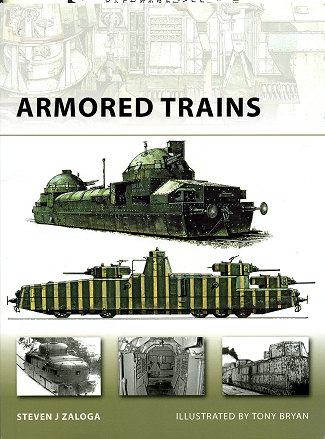 This
latest edition of the New Vanguard series is #140. For those that may be
unaware, this series is one of my favorites in the Osprey catalogue as it covers
the machinery of warfare. Those of us who like to model things find books like
this to be excellent references.
This
latest edition of the New Vanguard series is #140. For those that may be
unaware, this series is one of my favorites in the Osprey catalogue as it covers
the machinery of warfare. Those of us who like to model things find books like
this to be excellent references.
A subject that few know much about and many may not have
realized existed are armored trains. These were first used in the American Civil
War and while they were generally standard rail items modified with steel
plating or even rail ties for protection, they generally were good at what they
did. The most successful was a Union rail monitor used during the siege of
Petersburgh.
Next major use was the Boer war where war correspondent
Winston Churchill was in an armored train that was captured by the enemy. Again,
these were simply modified standard rail cars.
It wasn't until WWI when specialized armored trains were
developed with massive armor and even steel turrets. The Allies were not big
into them nor were the Germans. Trench warfare stifled the ability of these
highly mobile weapons platforms to be useful. It was on the Eastern side of
things that they were used a great deal. The Russian front was not trench
warfare and so it was the Russians who really became the master of the armored
train. Even after the armistice with Germany, these weapons were highly prized
and used considerably in the Bolshevik revolution and subsequent wars of the
early 1920.
It was natural that many of these trains would be used in
Eastern Russia so it was that the Chinese had the opportunity to not only see
these in action, but had many built for their own use against each other and
later against the Japanese. Several captured ones were used by the Japanese in
China later during WWII.
WWII saw probably the last use of the armored train. Again,
the Germans had little use for them, but did build several to use as flak cars
and some were used on the Russian front, where again, the Russians used a number
of these. But the end was in sight for it was seen that aircraft heavily limited
their movements and effectiveness.
Steven Zaloga tells the story of these interesting machines
and backed by superb period photos and the artwork of Tony Bryan, provides you
with an outstanding book on a truly unique subject. Get this one, you'll be
pleased you did.
January 2008
For more on the complete line of Osprey books,
visit www.ospreypublishing.com. In the US, it is
Osprey Direct at 44-02 23rd St, Suite 219, Long Island City, NY 11101., where you can
get a catalogue of available books.
If you would like your product reviewed fairly and quickly, please contact
me or see other details in the Note to
Contributors.
 This
latest edition of the New Vanguard series is #140. For those that may be
unaware, this series is one of my favorites in the Osprey catalogue as it covers
the machinery of warfare. Those of us who like to model things find books like
this to be excellent references.
This
latest edition of the New Vanguard series is #140. For those that may be
unaware, this series is one of my favorites in the Osprey catalogue as it covers
the machinery of warfare. Those of us who like to model things find books like
this to be excellent references.